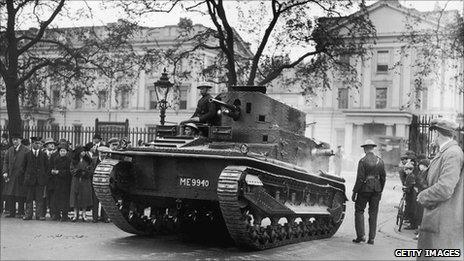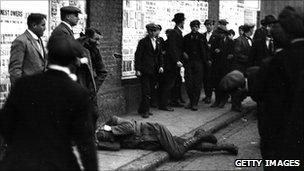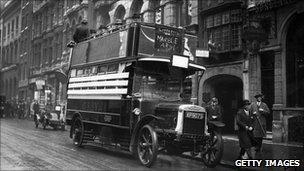What was the General Strike of 1926?
- Published

London was transformed into a city of rolling tanks, traffic jams and unrest
Trade unions opposed to public sector pension changes are threatening the biggest campaign of industrial action since the General Strike. But what happened during this benchmark strike in the 1920s, and just how big was it?
The strike was called by the TUC for one minute to midnight on 3 May, 1926.
For the previous two days, some one million coal miners had been locked out of their mines after a dispute with the owners who wanted them to work longer hours for less money.
In solidarity, huge numbers from other industries stayed off work, including bus, rail and dock workers, as well as people with printing, gas, electricity, building, iron, steel and chemical jobs.
The aim was to force the government to act to prevent mine owners reducing miners' wages by 13% and increasing their shifts from seven to eight hours.
The industrial action came against a backdrop of tough economic times following the First World War and a growing fear of communism.
Flying Scotsman derailed
On the first full day of action, on 4 May, there were estimated to be between 1.5 and 1.75 million people out on strike.

Strikers targeted volunteers
The transport network was crippled without its bus and train drivers, and roads became choked with cars.
The printing presses ground to a virtual halt and food deliveries were held up.
However, the armed forces were quickly moved to escort and protect food lorries, while volunteers got some buses back on the roads and trains on the rails.
Fights broke out between police and strikers in cities across the UK, from London to Glasgow.
In some places, police charged rioting strikers with batons, while in Northumberland, the Flying Scotsman train was derailed by strikers.
The government reacted aggressively, recruiting thousands of special policemen and sending a warship to Newcastle.
Striking 'sinful'
Stanley Baldwin, the prime minister at the time, appealed to people to trust him, in the first of a series of personal radio broadcasts to the nation during the strike.
"I am a man of peace. I am longing, and looking and praying for peace. But I will not surrender the safety and the security of the British constitution.
"Cannot you trust me to ensure a square deal and to ensure even justice between man and man?"

Bus windows had to be barricaded to protect drivers from attack
At the same time, the Conservative government was trying to exert greater control over the media, including the fledgling BBC, to get its message out.
It even briefly turned publisher, producing its own newspaper, the British Gazette, edited by the then Chancellor Winston Churchill. The Roman Catholic Church also spoke out, declaring the strike "a sin"
Meanwhile, a growing number of Britons were becoming volunteers, desperate to get the country back on its feet.
And, nine days after it began, the TUC, which had been holding secret talks with the mine owners, called off the strike without a single concession made to the miners' case.
The strikers were taken by surprise, but drifted back to work.
The miners though struggled on alone and by the end of November most were back down the mines, working for less pay and longer hours. Others remained unemployed for many years.
A year later, Mr Baldwin's government passed the 1927 Trades Disputes Act, which banned sympathy strikes and mass picketing.
The act was repealed in 1946, but in the 1980s the then Prime Minister Margaret Thatcher reintroduced the ban, which still applies today.
- Published18 June 2011